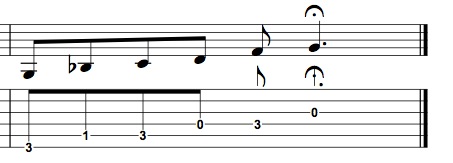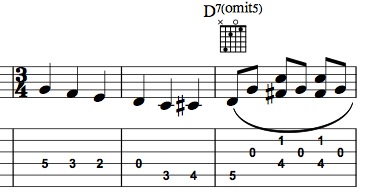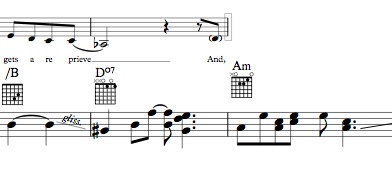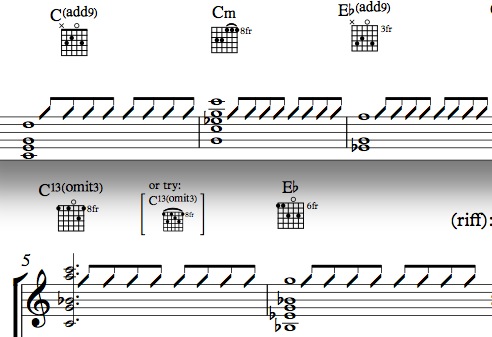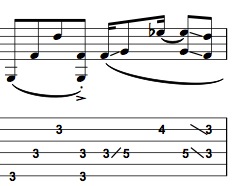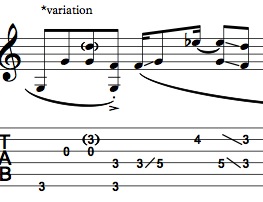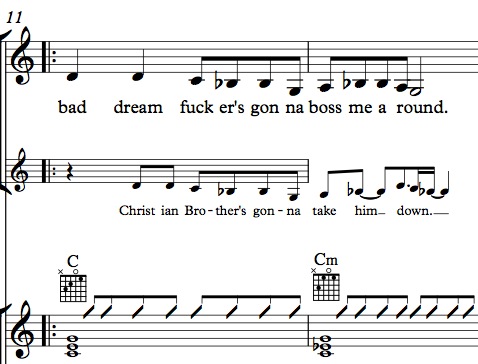Transcription & Analysis: Elliott Smith
by Lennox
Pentatonicism & Voice Leading
update (May 2015): broken links fixed
This is the first installment of Transcription & Analysis; a new series where I will transcribe popular music and then offer theoretical analysis on the subjects. Generally, when I am told to listen to an artist, or that they are “good,” etc., people can’t really give me objective reasons to appreciate the music. The point of this series is to present objective events in the songs in order to explain how they work. Stay with me for the next couple of months and I’ll show you.
.
* * * *
10 years is a long time without Elliott Smith.
I have included 3 transcriptions here of songs that I feel have not been documented properly up until this point plus a bonus song. The songs are from what fans refer to as The Basement Era, and are meaningful because they are some of Elliott’s final work before his death in 2003.
From A Basement On The Hill was actually completed and released posthumously using material he had recorded, but remains controversial as unsavory creative decisions and song inclusions (and many exclusions) were made by Elliott’s family. For Example, Suicide Machine (aka Tiny Time Machine) is apparently the last song he worked on in studio. It did not make the cut for A Basement but is nevertheless musically relevant and cohesive to the album as we will see in my analysis below.
.
.
* * * *
* * * *
Transcriptions
.
* * * *
* * * *
.
* * * *
Analysis
A Fond Farewell
The song is in A minor, but is played with a capo on 2nd fret, therefore is heard in the key of B minor. I have transcribed the song in A minor for simplicity. It is interesting to note Elliott’s economy of material right away. In measures 1-4 The bass is playing a subject that is recapitulated in simple variation of the lead guitar part in the Chorus (m. 23). Same notes, new octave.
It is important to note the pentatonic scales that Elliott is using quite extensively in this song and others. In mm. 7-8 this is very obvious as we hear the lead guitar (doubled by bass guitar) come down in a variation of the first subject and descend all 5 notes of E minor / G major pentatonic scale (missing C & F#). This hook is heard again to re-introduce each Verse section, as well as against a Parallel Third later in the conclusion. This intro melody is actually a loose quote based on the Chorus vocal melody
Similar pentatonic embellishments can be heard in the vocal melody, for example in m. 12 or 20 (usually at the end of a phrase). Major (and relative minor) Pentatonic scales are used very commonly in popular music because the tonal tritone (4th and 7th scale degree) is removed, along with possibilities of dissonance. The result is usually a more pleasing and singable melody, and these scales also have a history in many world music traditions dating back hundreds maybe thousands of years.
A Fond Farewell actually ends with an ascending G pentatonic minor scale:
Smith uses several voice leading techniques in his writing that I believe have big payoffs. Voice Leading is essentially a set of rules for western harmony; music with more than one “voice” (or any instrument that produces pitch). These rules are sometimes referred to as Principles of Voice Leading.
The 1st principle of voice leading that Elliott uses can be known as common tone. The idea is that as chords change, some of the notes in those chords may be the same. For example:
- a C chord is made up of the notes C-E-G
- a G chord is made up of the notes G-B-D
The common tone in these two triad chords is G. So, when a voice maintains the same note through a chord change (i.e. uses a common tone) it is considered good voice leading. At the beginning of the verse (mm. 9-10) the bass guitar plays G through the chords I just mentioned, G to C (or C/G – “C over G” because of the G in the bass).
This principle is also demonstrated in the first subject mentioned at the top– the lead guitar line in the Chorus holds onto common tones for each of the chord changes in the Chorus (mm. 23-26)
And recapitulations of a static G note again in the bass line, and tagging the vocal melody in the Chorus (see mm. 25-26):

Bass guitar mm. 25-26
In a development in the song’s conclusion, Elliott uses a harmonic device known as Modal Mixture or borrowed chord. C moves to C (parallel) minor as the E drops to an Eb. On the G chord, the previous Eb resolves down to D in chromatic motion, which is considered good voice leading. (see m. 48)
Parallel motion (i.e. thirds & sixths) is not always considered wrong in traditional western harmony, but other types of motion are sometimes preferred or considered stronger. The secondary vocal in this song uses oblique (m.34) and similar (m.35) motion while somehow ending with parallel octaves. That’s 3 out of 4 types.
* * * *
* * * *
King’s Crossing
(.PDF)
Something that is very interesting about A Basement to me is the drone aesthetic found in many of the tracks. Just like first cut Coast To Coast, King’s Crossing starts with droning guitar noise, reverb, synth, long sustained singing and mumbling. I tried to capture some of the tones that are occurring through the intro in my transcription, but obviously it’s pretty difficult to hear every one.
Please note the intro is through composed (probably improvised), so a real pulse doesn’t begin until m. 12 in my transcription, where a piano plays a waltz intro. I have transcribed that piano part for guitar and included diagrams.
Elliott continues to demonstrate principles of voice leading in this song by usually following the rule that the 7th of any seventh chord should resolve downwards. This is apparent before measure 20, as E7 (V7 of vi) changes to Am7.
- E7 is made up of the notes E(1) – G#(3) – B(5) – D(7)
The D on top of the E7 voicing (m. 18) resolves down to C in m. 20.
- Am7 in measure 20 is made up of the notes: A(1) – C(3) – E(5) – G(7)
In this case, the 7 does not resolve down but it does not have to because the next chord contains that same note. This is a suspension, so resolving down isn’t necessary because that note is already in the next chord.
- D7(add4) in measure 22 is made up of the notes: D(1) – F#(3) – A(5) – C(7)
In measure 22 the C in D7 is held through F and finally resolves down to B in E7 (not in diagram). So it does eventually resolve down.
Elliott uses another type of seventh chord called a Diminished Seventh, which is essentially just a stack of minor thirds (or a diminished triad with another minor 3rd on top). You don’t see these chords very often in pop or folk music but you do see them more often in traditional classical and other styles like jazz; they have a dark, menacing tone.
In the verse (m. 30), there is a Ddim7 chord notated in the transcription. Diminished chords are notated with a degrees symbol. I think you could argue this is actually just a broken G# diminished triad, but the voiced D on the last beat makes it sound otherwise. Note the chord is approached by a descending minor third.
It’s interesting to discuss the similarities that some of these chords have when using them: (keep in mind G# and Ab are the same thing).
- Ddim7 is made up of the notes D(1) – F(3) – Ab(5) – B(7)
- G#dim is made up of the notes G# – B – D
- G#dim7 is made up of the notes G#(1) – B(3) – D(5) – F(7)
- E7 is made up of the notes E(1) – G#(3) – B(5) – D(7)
The dim7 chords are so similar because they function in a special way. Each inversion of a diminished seventh is actually the root position of another dim7 chord. So G#dim7 is actually an inversion of Ddim7, even though they are both in root position — which is why they contain the same notes.
Look at the similarity to E7. For those of you with an understanding of perfect cadences, You’ll see that E7 is 5 (or V) of A minor. Because these chords are very close in the notes they have in common, they function almost the same. So it is possible to use a Ddim7 as a functioning dominant in this case.
Of course, G#dim7 would be the diatonic leading note chord of A minor (if you built a four note chord in A harmonic minor starting at the raised 7th, G#).
* * * *
* * * *
Suicide Machine
(.PDF)
This song was first recorded as an instrumental called Tiny Time Machine and both demo recordings are widely available for listening(i.e. Youtube) though they have never been officially released. If you listen to Tiny Time Machine and Suicide Machine and compare, there are actually very few differences. I get the impression Elliott went into the studio and asked to specifically pull up that instrumental so he could lay down lead vocals and that’s pretty much it. Listen for yourself.
It is also interesting to listen to the guitar tones and compare to other songs. Listen to the amplifier and specific characteristics of the tremolo effect, and compare to Fond Farewell for example. I hear similar tones in other songs on From A Basement…
The song again uses pentatonic scales quite a bit. The slide guitar intro starts in measure 1 with a descending E pentatonic minor scale (C & F# missing), and ultimately ends up resolving on G, the relative major tonic. The song is in G major.
The intro guitar melody is really just a loose quote based on the descending pentatonic melody of the chorus:
Elliott’s songs usually have more chords than average, but this progression is particularly verbose and challenging:
This chord progression contains a familiar Elliott Smith trick of raising just the tonic of the I chord to form a biidim (flat-two diminished) chord, before returning again to the tonic. It could be called a passing chord, except that it’s not actually functioning that way. Therefore I believe it is a prolongation of the tonic. You also hear it in: St. Ides Heaven, and others.
The coda emphasizes instability with a repeating 3-measure pattern in the conclusion of the song. This pattern actually acts like a Deceptive Cadence (V – vi), as the tonal tritone (F# & C) resolve accordingly and Leading Note actually moving downwards.
* * * *
* * * *
Christian Brothers
(.PDF)
It was to my surprise that a previously unheard recording of this song was made available on soundcloud on the 10th Anniversary of Elliott’s passing by some guy named Tony Lash. That is an old Heatmiser recording, but I have actually transcribed the version that appears on his solo, acoustic self-titled. It’s actually an elusive song to pin down, and I still haven’t seen any decent transcriptions yet so I thought I would throw this one up here too.
This song is really just a brilliant prolongation of the tonic. For example, we can get to Eb from C with a Cm in the middle (common tone). This could be a modulation into E-flat or related key, but instead we hear a tonic chord with ambiguous third, which is just to be followed with the major 3rd on repeat.
Two variations on the riff heard in the Verse section(s) :
These riffs imply a G7 (G – B – D – F), which is interesting when considering a perfect cadence against the alternating qualities of C chords in the Verse.
In very stark contrast to some of the other From A Basement songs, Christian Brothers is actually getting pretty far away from Pentatonic sounds. A large part of the verse melody (mm. 11 – 12) is sung on the 7th of C (as the quality of that chord changes from major to minor).
Elliott returns to and emphasizes the B-flat again as a low point of the Chorus melody (mm.18-20)
Also notice in the Chorus melody that Elliott is careful not to sing any Es except for the E-flat over Cm, so that none of the notes clash with this apparent prolongation of the tonic.
Corrections & Comments welcome:



